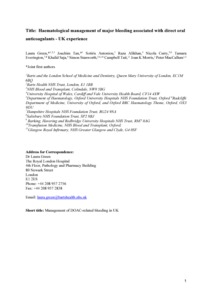Green, L;
Tan, J;
Antoniou, S;
Alikhan, R;
Curry, N;
Everington, T;
Saja, K;
Stanworth, S;
Tait, C;
Morris, JK;
et al.
Green, L; Tan, J; Antoniou, S; Alikhan, R; Curry, N; Everington, T; Saja, K; Stanworth, S; Tait, C; Morris, JK; MacCallum, P
(2019)
Haematological management of major bleeding associated with direct oral anticoagulants – UK experience.
BRITISH JOURNAL OF HAEMATOLOGY, 185 (3).
pp. 514-522.
ISSN 0007-1048
https://doi.org/10.1111/bjh.15808
SGUL Authors: Tan, Joachim Wei Li
![[img]](https://openaccess.sgul.ac.uk/110493/1.hassmallThumbnailVersion/DOAC%20paper_BJH_revised%20version%20DepositCopy.pdf)  Preview |
|
PDF
Accepted Version
Available under License ["licenses_description_publisher" not defined].
Download (445kB)
| Preview
|
Abstract
The lack of antidotes for activated factor X‐inhibitor direct oral anticoagulants (DOACs) means that management of bleeding consists largely of existing supportive therapies. This study aimed to: (i) examine the relative frequency of DOAC‐related major bleeding in relation to DOAC prescriptions over the study period; (ii) describe the presentation and haematological management of DOAC‐related major bleeding; and (iii) evaluate the association between the use of prothrombin‐complex‐concentrate (PCC) and in‐hospital mortality. Over a 3‐year period, 32 UK hospitals submitted data on haematological management of DOAC‐related bleeding. Data consisted of 421 episodes (67%, 21%, 11% and 1% on rivaroxaban, apixaban, dabigatran and edoxaban respectively) of major bleeding on DOACs. The proportion of major bleeds on DOACs and DOAC prescriptions increased throughout the study. Overall, 44% and 37% of patients presented with gastrointestinal bleeding and intracranial haemorrhage (ICH) respectively. Drug concentrations were seldom measured. Compared to no PCC, there was a borderline evidence that receiving low dose PCC (≤25 iu/kg) was associated with better outcomes in terms of mortality (sub‐distribution hazard ratio: 0·15; 95% confidence interval: 0·02–1·19; P = 0·07): but this was not the case for higher doses. DOAC concentrations are seldom measured. There was no evidence of benefit for PCC on in‐hospital mortality.
| Item Type: |
Article
|
| Additional Information: |
This is the peer reviewed version of the following article: Green, L. , Tan, J. , Antoniou, S. , Alikhan, R. , Curry, N. , Everington, T. , Saja, K. , Stanworth, S. , Tait, C. , Morris, J. K. and MacCallum, P. (2019), Haematological management of major bleeding associated with direct oral anticoagulants – UK experience. Br J Haematol, 185: 514-522, which has been published in final form at https://doi.org/10.1111/bjh.15808. This article may be used for non-commercial purposes in accordance with Wiley Terms and Conditions for Use of Self-Archived Versions. |
| Keywords: |
1102 Cardiovascular Medicine And Haematology, Immunology |
| SGUL Research Institute / Research Centre: |
Academic Structure > Population Health Research Institute (INPH) |
| Journal or Publication Title: |
BRITISH JOURNAL OF HAEMATOLOGY |
| ISSN: |
0007-1048 |
| Publisher License: |
Publisher's own licence |
| Projects: |
|
| URI: |
https://openaccess.sgul.ac.uk/id/eprint/110493 |
| Publisher's version: |
https://doi.org/10.1111/bjh.15808 |
Statistics
Item downloaded times since 08 Jan 2019.
Actions (login required)
 |
Edit Item |


